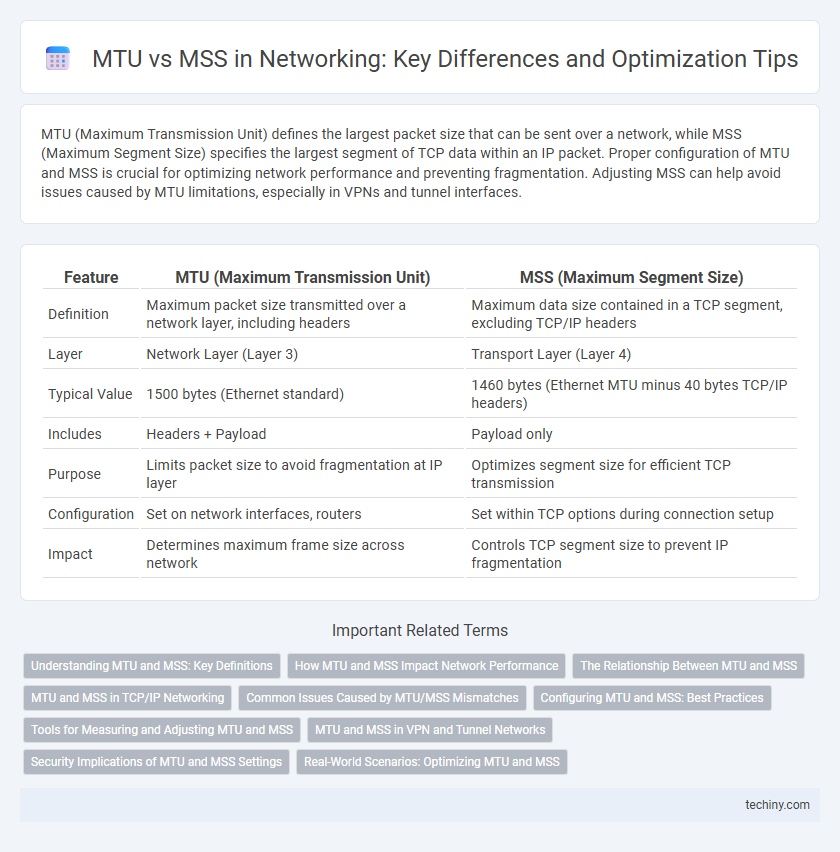MTU (Maximum Transmission Unit) defines the largest packet size that can be sent over a network, while MSS (Maximum Segment Size) specifies the largest segment of TCP data within an IP packet. Proper configuration of MTU and MSS is crucial for optimizing network performance and preventing fragmentation. Adjusting MSS can help avoid issues caused by MTU limitations, especially in VPNs and tunnel interfaces.
Table of Comparison
| Feature | MTU (Maximum Transmission Unit) | MSS (Maximum Segment Size) |
|---|---|---|
| Definition | Maximum packet size transmitted over a network layer, including headers | Maximum data size contained in a TCP segment, excluding TCP/IP headers |
| Layer | Network Layer (Layer 3) | Transport Layer (Layer 4) |
| Typical Value | 1500 bytes (Ethernet standard) | 1460 bytes (Ethernet MTU minus 40 bytes TCP/IP headers) |
| Includes | Headers + Payload | Payload only |
| Purpose | Limits packet size to avoid fragmentation at IP layer | Optimizes segment size for efficient TCP transmission |
| Configuration | Set on network interfaces, routers | Set within TCP options during connection setup |
| Impact | Determines maximum frame size across network | Controls TCP segment size to prevent IP fragmentation |
Understanding MTU and MSS: Key Definitions
MTU (Maximum Transmission Unit) defines the largest packet size a network interface can transmit without fragmentation, typically measured in bytes. MSS (Maximum Segment Size) is the largest segment of TCP data that a device can receive in a single segment, calculated by subtracting the TCP and IP header sizes from the MTU. Accurate configuration of MTU and MSS enhances network efficiency by preventing packet fragmentation and optimizing data flow in TCP/IP communications.
How MTU and MSS Impact Network Performance
MTU (Maximum Transmission Unit) defines the largest packet size a network interface can transmit, while MSS (Maximum Segment Size) specifies the maximum data size a TCP segment can carry without fragmentation. An appropriately configured MTU prevents packet fragmentation, reducing latency and improving throughput, whereas an optimized MSS ensures TCP segments fit within the MTU limits, minimizing retransmissions and packet loss. Incorrect MTU or MSS settings lead to increased fragmentation, higher latency, and decreased network efficiency, negatively impacting overall network performance.
The Relationship Between MTU and MSS
MTU (Maximum Transmission Unit) defines the largest packet size that can be transmitted over a network layer without fragmentation, typically 1500 bytes for Ethernet. MSS (Maximum Segment Size) is the largest segment of TCP data a device can receive, calculated by subtracting the TCP and IP header sizes (usually 40 bytes) from the MTU. Properly setting MSS based on the MTU prevents fragmentation, optimizing network performance and reducing latency during data transmission.
MTU and MSS in TCP/IP Networking
Maximum Transmission Unit (MTU) defines the largest packet size that can be transmitted over a network layer without fragmentation, typically 1500 bytes for Ethernet. Maximum Segment Size (MSS) is the largest TCP segment payload size, calculated by subtracting TCP and IP header sizes from the MTU to prevent fragmentation. Proper MTU and MSS configuration optimizes TCP/IP performance, reducing overhead and avoiding packet fragmentation in network communications.
Common Issues Caused by MTU/MSS Mismatches
MTU and MSS mismatches often cause packet fragmentation, leading to increased latency and reduced throughput in network communication. TCP connections may experience frequent retransmissions and connection timeouts due to dropped packets when the MSS exceeds the MTU size after encapsulation. Proper alignment of MTU and MSS settings is crucial to prevent performance degradation and ensure smooth data transmission across network links.
Configuring MTU and MSS: Best Practices
Configuring the Maximum Transmission Unit (MTU) and Maximum Segment Size (MSS) requires aligning MTU settings with the underlying network infrastructure to prevent fragmentation and optimize throughput. Best practices include setting the MSS in TCP connections slightly lower than the MTU minus the IP and TCP header sizes to ensure packets fit within the MTU limits. Consistent MTU and MSS configuration across devices minimizes packet loss, reduces latency, and enhances overall network performance.
Tools for Measuring and Adjusting MTU and MSS
Tools like ping and tracepath enable network administrators to measure the Maximum Transmission Unit (MTU) by sending packets of varying sizes to detect fragmentation points. TCP packet analyzers such as Wireshark provide insights into the Maximum Segment Size (MSS) by examining the TCP handshake options and adjusting MSS values to optimize throughput and reduce fragmentation. Network devices and operating systems often include command-line utilities (e.g., ip link, ifconfig, sysctl) to configure and fine-tune MTU and MSS settings for improved performance and reduced latency.
MTU and MSS in VPN and Tunnel Networks
MTU (Maximum Transmission Unit) defines the largest packet size that can be transmitted on a network without fragmentation, while MSS (Maximum Segment Size) specifies the largest segment size TCP can handle within that MTU. In VPN and tunnel networks, the encapsulation overhead reduces the effective MTU, requiring careful MSS adjustment to prevent packet fragmentation and ensure optimal data flow. Proper configuration of MTU and MSS in tunnels improves performance by minimizing retransmissions and latency caused by fragmented packets.
Security Implications of MTU and MSS Settings
MTU (Maximum Transmission Unit) and MSS (Maximum Segment Size) settings significantly impact network security by influencing packet fragmentation and exposure to certain attack vectors like IP fragmentation attacks. Incorrect MTU and MSS configurations can lead to packet drops or allow attackers to exploit fragmented packets for evasion techniques or denial-of-service attacks. Optimizing these values helps maintain secure and efficient data transmission, reducing the risk of fragmentation-based vulnerabilities.
Real-World Scenarios: Optimizing MTU and MSS
Optimizing MTU and MSS in real-world networking scenarios enhances data transmission efficiency by minimizing fragmentation and latency. Adjusting MTU size to align with the smallest link in the path prevents packet loss, while tuning MSS in TCP connections ensures optimal segment size for network throughput. Network engineers leverage tools like ping tests with specific payload sizes and TCP tuning parameters to balance performance and reliability across diverse network environments.
MTU vs MSS Infographic

 techiny.com
techiny.com